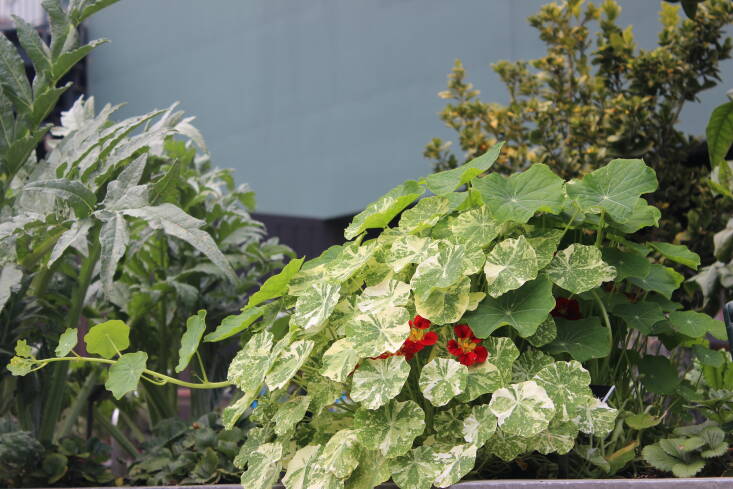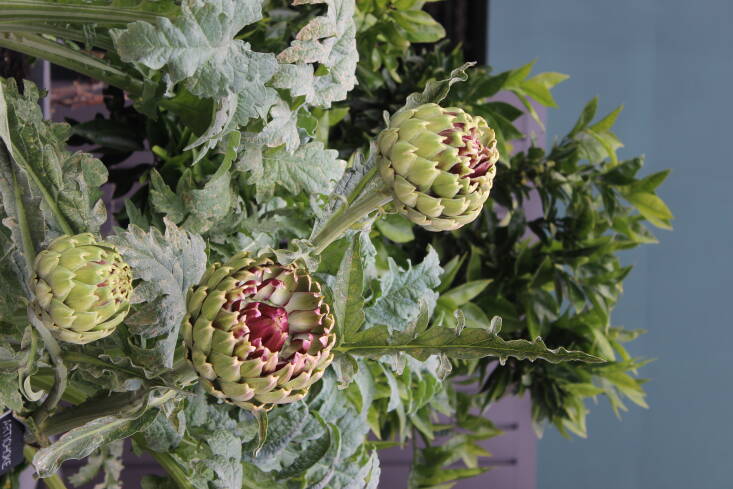Gardening and baseball? Not the most likely combination. But inside San Francisco’s famed Oracle Park—just behind center-field, tucked between bleachers and under the massive scoreboard—is a thriving, productive, well-used, and visually appealing edible garden. And despite the brutal wind, foggy climate, and challenging growing conditions, the garden successfully produces an assortment of herbs, fruits, and vegetables. So yes, this garden is a total home run.
Please join us as we look around:
Photography by Kier Holmes.
The Background

In 2014, the Garden at Oracle Park was created by a partnership between the SF Giants and Bon Appetit Management Company, for multiple purposes. For starters, the Garden supplies the Park’s two bistros with fresh vegetables, fruit, and herbs that inspire many of their offerings as well as the drinks at the bar. The chefs harvest whatever produce is currently ripe and ready to use in their dishes. In addition, the Garden is a way to show Giants fans the benefits of urban farming; it even serves as an outdoor classroom where kids learn about making good food choices and preparing garden-fresh meals.
Prioritizing Sustainability

Constant care is critical to the health and visual appeal of Oracle Park’s edible garden, and this is expertly tackled by Lara Hermanson, co-owner and principal of Farmscape, California’s largest urban farming company. Lara’s green team keeps a watchful eye over things and makes sure they are also looking ahead. To address climate change and California’s looming drought conditions, the Garden at Oracle Park is designed to be low-water and sustainable, featuring edible crops complemented by native, drought-tolerant plants. Lara explains, “Drip irrigation is non-negotiable in all of our projects because of the huge water savings and the vast improvement in food crops when they are irrigated this way.” She adds, “Plus, it’s a little neater if irrigation needs to run when fans are in the space!”
Healthy soil is also a critical piece. Lara uses only certified organic soil and compost from Kellogg, which she says is, “the Rolls Royce of soil amendments.” Farmscape is committed to integrated pest management (IPM) so they use hand removal techniques, design with proper spacing and airflow, prune smartly, and use natural sprays like insecticidal soap to keep plants pest-free.
Fighting Fog, Wind, and Crowds

If you live in or have visited San Francisco, you know that the fog is so consistent and prevalent that it has a nickname: Karl. But when you want to grow edibles, Karl, along with chilling winds, can make gardening a challenge. “There exists a natural wind tunnel between the Bay and the field. Pairing that with the cool weather we have much of the year and it’s the perfect habitat for powdery mildew,” Lara explains. She would love to grow plants like Sungold tomatoes or Black Cobra peppers (see the color theme?) but can’t because nightshades really struggle as mildew latches on early in June and kills the plants before they have enough heat to ripen. However, Lara isn’t daunted or hindered by these grim conditions. She simply makes sure to choose the right crops given the microclimate there.

Another huge challenge is keeping the garden looking perfect when thousands of fans stream through during every 80-plus home game each year, not to mention the big concerts that the Garden also attracts. After events, the it can look a bit “partied out.” Lara shares that while many fans ooh and ahh at the gorgeous plantings, many others engage by sitting or standing on the garden to get a better view, occasionally trampling plants. But it’s all good. Lara and her crew just have to schedule maintenance time after a show, and during baseball season, they gather each morning to assess damage, clean up, and fix it all up in time for the next game. “It’s exciting,” says Lara. “It’s like getting ready for a show every night!”
Choosing the Right Crops

Instead of trying to force certain plants to grow, Lara focuses on what works and has adjusted the crop collection to include hardy and fog and wind-tolerant plants like kale, chard, salad greens, silver and lemon thyme, artichokes, Sunshine blueberries, strawberries, and pineapple guava. Olive trees also thrive in the space, as do kumquat, mandarin, and lime trees. It also turns out that there has always been an avocado tree in the stadium, the first one planted by a previous Giants groundskeeper. Lara says, “There must be some magic here because it keeps thriving despite cold, foggy conditions.”









Have a Question or Comment About This Post?
Join the conversation